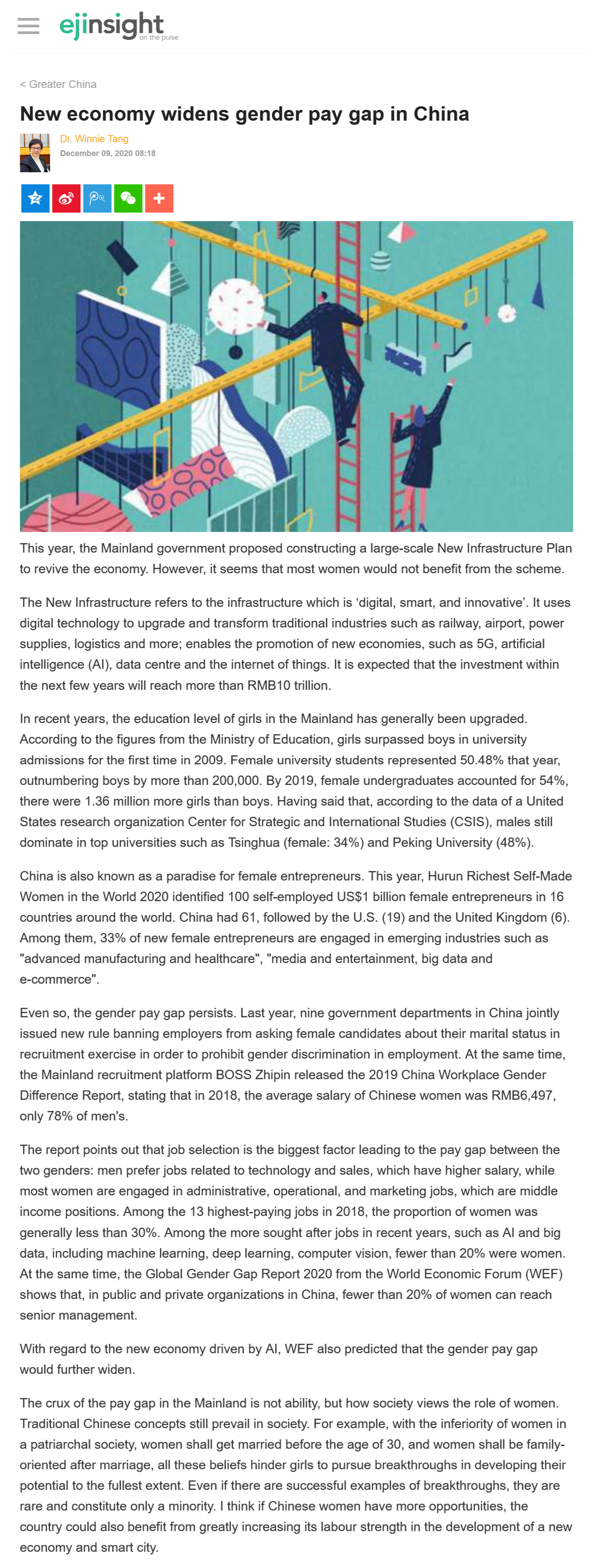網上版請按此

New economy widens gender pay gap in China
This year, the Mainland government proposed constructing a large-scale New Infrastructure Plan to revive the economy. However, it seems that most women would not benefit from the scheme.
The New Infrastructure refers to the infrastructure which is 'digital, smart, and innovative'. It uses digital technology to upgrade and transform traditional industries such as railway, airport, power supplies, logistics and more; enables the promotion of new economies, such as 5G, artificial intelligence (AI), data centre and the internet of things. It is expected that the investment within the next few years will reach more than RMB10 trillion.
In recent years, the education level of girls in the Mainland has generally been upgraded. According to the figures from the Ministry of Education, girls surpassed boys in university admissions for the first time in 2009. Female university students represented 50.48% that year, outnumbering boys by more than 200,000. By 2019, female undergraduates accounted for 54%, there were 1.36 million more girls than boys. Having said that, according to the data of a United States research organization Center for Strategic and International Studies (CSIS), males still dominate in top universities such as Tsinghua (female: 34%) and Peking University (48%).
China is also known as a paradise for female entrepreneurs. This year, Hurun Richest Self-Made Women in the World 2020 identified 100 self-employed US$1 billion female entrepreneurs in 16 countries around the world. China had 61, followed by the U.S. (19) and the United Kingdom (6). Among them, 33% of new female entrepreneurs are engaged in emerging industries such as "advanced manufacturing and healthcare", "media and entertainment, big data and e-commerce".
Even so, the gender pay gap persists. Last year, nine government departments in China jointly issued new rule banning employers from asking female candidates about their marital status in recruitment exercise in order to prohibit gender discrimination in employment. At the same time, the Mainland recruitment platform BOSS Zhipin released the 2019 China Workplace Gender Difference Report, stating that in 2018, the average salary of Chinese women was RMB6,497, only 78% of men's.
The report points out that job selection is the biggest factor leading to the pay gap between the two genders: men prefer jobs related to technology and sales, which have higher salary, while most women are engaged in administrative, operational, and marketing jobs, which are middle income positions. Among the 13 highest-paying jobs in 2018, the proportion of women was generally less than 30%. Among the more sought after jobs in recent years, such as AI and big data, including machine learning, deep learning, computer vision, fewer than 20% were women. At the same time, the Global Gender Gap Report 2020 from the World Economic Forum (WEF) shows that, in public and private organizations in China, fewer than 20% of women can reach senior management.
With regard to the new economy driven by AI, WEF also predicted that the gender pay gap would further widen.
The crux of the pay gap in the Mainland is not ability, but how society views the role of women. Traditional Chinese concepts still prevail in society. For example, with the inferiority of women in a patriarchal society, women shall get married before the age of 30, and women shall be family-oriented after marriage, all these beliefs hinder girls to pursue breakthroughs in developing their potential to the fullest extent. Even if there are successful examples of breakthroughs, they are rare and constitute only a minority. I think if Chinese women have more opportunities, the country could also benefit from greatly increasing its labour strength in the development of a new economy and smart city.
Dr. Winnie Tang
Adjunct Professor, Department of Geography, Faculty of Social Sciences and Faculty of Architecture, The University of Hong Kong